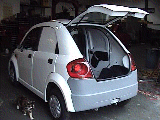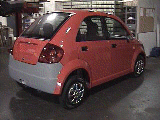 I dropped in on the local electric car dealership the other day to kick some tires and see what’s new. I especially liked the look of one model. It has four doors and a hatchback and is about the size and shape of the old VW Bug. When I checked under the hood I found six 12-volt, lead-acid batteries. It also did not have a transmission.
I dropped in on the local electric car dealership the other day to kick some tires and see what’s new. I especially liked the look of one model. It has four doors and a hatchback and is about the size and shape of the old VW Bug. When I checked under the hood I found six 12-volt, lead-acid batteries. It also did not have a transmission.
 Certainly, using lead-acid batteries and eliminating the transmission are engineering compromises that should go a long way toward keeping costs down. I have always been enamored with the simplicity of an electric car like this one. It has no radiator, thermostat, water pump, antifreeze or hoses, no exhaust manifold or mufflers, no fuel tanks, fuel pumps, fuel filters, or injectors, no oil, no oil pump, no oil filters, no air filters, no air pollution devices, no transmission, no transmission fluid — just an electric motor and a handful of batteries. The cost of producing an electric motor is a hundred times less than that of producing a reciprocating engine in comparable quantities. If this simple little car were mass-produced in numbers matching a typical economy car it would cost about $5000. Unfortunately, because so few are produced, this sedan sells for around $14,000. Not much of a bargain when you consider that you can buy a brand new economy car for about $10,000 that gets 35 MPG, has a range of several hundred miles, and is capable of propelling you and three passengers over mountain passes at 60 MPH.
Certainly, using lead-acid batteries and eliminating the transmission are engineering compromises that should go a long way toward keeping costs down. I have always been enamored with the simplicity of an electric car like this one. It has no radiator, thermostat, water pump, antifreeze or hoses, no exhaust manifold or mufflers, no fuel tanks, fuel pumps, fuel filters, or injectors, no oil, no oil pump, no oil filters, no air filters, no air pollution devices, no transmission, no transmission fluid — just an electric motor and a handful of batteries. The cost of producing an electric motor is a hundred times less than that of producing a reciprocating engine in comparable quantities. If this simple little car were mass-produced in numbers matching a typical economy car it would cost about $5000. Unfortunately, because so few are produced, this sedan sells for around $14,000. Not much of a bargain when you consider that you can buy a brand new economy car for about $10,000 that gets 35 MPG, has a range of several hundred miles, and is capable of propelling you and three passengers over mountain passes at 60 MPH.
It would also cost roughly $1000 to replace the batteries, and you could expect to do that in about three years. Every car in the world has a lead-acid battery in it and the infrastructure already exists for recycling them. At least disposing of the old ones would not be a problem.
The manufacturer is caught in the typical supply/demand paradox. Without major improvements in quality and without a reasonable price resulting from much higher production rates, few people are going to buy it. They definitely got the look right. If they added power steering, a steel roll cage for safety, small batteries in reserve to be used only in an emergency, something bigger than the current 5 horsepower motor, and vastly better quality, they would really be onto something. This is a sweet looking car. They are so close but if they can’t do a better job of manufacturing and engineering this product, it just isn’t going to catch on.
If these cars cost far less, were of better quality, and had the safety of a real car, I would seriously consider getting one for my teenage daughter to use to haul herself and her little sister to school. It cannot go over 30 MPG and has range of about 30 miles — a parent’s dream car. It is so simply constructed, I could swap the batteries out myself in a few hours and it would need no other maintenance.
Just as the turbine revolutionized air travel, electric motors have the potential to revolutionize ground transport. Before the turbine came along, aircraft powerplants had reached ridiculous levels of complexity. The reciprocating radial engines that powered the last of the prop airliners had 24 cylinders and 48 spark plugs. There were hundreds of moving parts, all slamming into each other and experiencing thousands of sudden direction reversals every minute. By contrast, the turbine engine, like an electric motor, has only one moving part that hums along in a simple rotational movement. Analogously, today’s cars have reached ridiculous levels of complexity.
 I dropped in on the local electric car
I dropped in on the local electric car 

